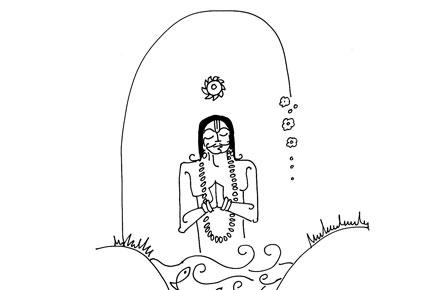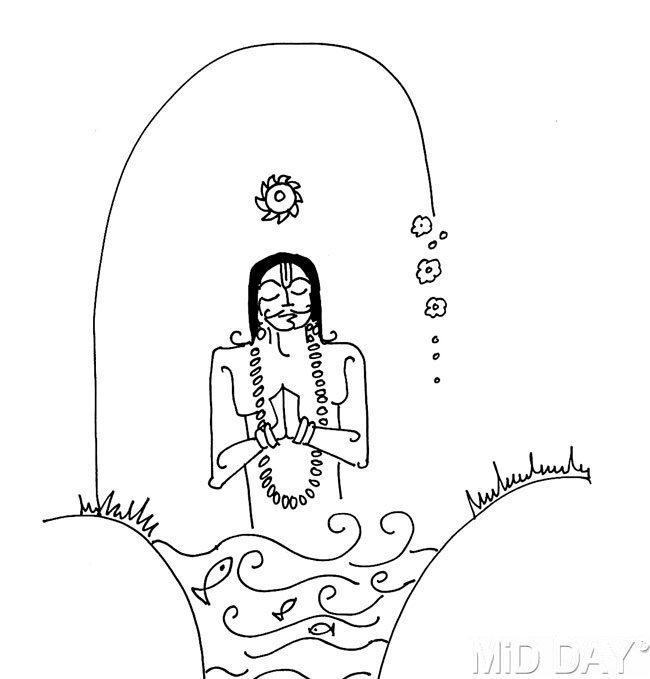As a child I was never told stories of how Ram died or how Krishna died. There were whispers here and there but no images on temple walls.

 As a child I was never told stories of how Ram died or how Krishna died. There were whispers here and there but no images on temple walls. I found these stories much later in life. In the Ramayana, Ram dies by walking into the river Sarayu unable to live after Sita disappears into the earth. In the Mahabharata, Krishna dies when he is accidentally shot by a hunter who mistakes his toe for a deer’s snout.
As a child I was never told stories of how Ram died or how Krishna died. There were whispers here and there but no images on temple walls. I found these stories much later in life. In the Ramayana, Ram dies by walking into the river Sarayu unable to live after Sita disappears into the earth. In the Mahabharata, Krishna dies when he is accidentally shot by a hunter who mistakes his toe for a deer’s snout.

Illustration/ Devdutt Pattanaik
ADVERTISEMENT
When I narrated these discoveries, I was surprised that many knew them but chose to ignore them. They insisted that Ram and Krishna did not really die. Some said that they returned to Vaikuntha, their heavenly abode. Others preferred the word ‘samadhi’ to ‘mrityu’. I also noticed that no rituals are held to mark these events in contrast to the many events associated with the birth of gods and their victories in battle. Perhaps this is the reason that Vedic Indians never built tombs: the body was burned and the ashes scattered in the river, enabling the dead to return to the land of the dead from where they would
eventually be reborn.
But the desire to cling to death or at least the memory of life remained as we see from the many ‘Vira’ stones found across the Deccan, commemorating the heroic deeds of warriors. In Rajasthan, we find ‘Sati’ stones commemorating the women who burn themselves alive on the funeral pyres of their husbands. Monastic orders in India, to some extent, mark death (or liberation, as the faithful prefer) when they build tombs to gurus and acharyas. This practice probably began after the relics of Buddha, such as his hair or tooth or nail, were stored in stupas by his followers despite Buddha’s message of impermanence.
When Islam came to India, the idea of tombs became very popular. Many people are surprised when you tell them that the beautiful ‘Taj Mahal’ is a tomb, not a palace. The sultans were greatly influenced by the Persian practice of building tombs for their kings and the Persian kings were following the practice of ancient pre-Islamic rulers of Persia. In the older Zoroastrian practice of Persia, the body was left in the open in the Tower of Silence for vultures to feed on and thus returned to nature.
Death is a key event in the Islamic tradition, especially amongst Shias. The martyrdom of Ali Hussein at the battle of Karbala in the 7th century heralded the split in Islam between the Sunnis and the Shias. Every year this event is marked by ritual mourning by Shias across the world during Muharram. Building of shrines around Sufi mystics is widespread though there is little mourning and more celebration around death as it marks union with divinity.
Mourning is also a key theme of Good Friday, the day marking the day when Jesus Christ was crucified. The following Sunday, Easter Sunday, marks the resurrection and renewal. Many have pointed out that this Christian practice, along with the ceremonial use of eggs and rabbits, points to an ancient pagan festival associated with death and resurrection of a fertility god such as Dumuzi in Sumeria and Adonis in Asia Minor. This god would die each winter at harvest time and return every spring at sowing time. The earth-goddess would mourn his death and celebrate her arrival, along with her devotees.
We can only wonder if the tombs of political leaders — so critical for nation state mythology — can be traced to Buddhist stupas, guru samadhis, Vira or Sati stones, Sufi dargahs, or sultanate tombs. We want to hold on, not move on.
The author is Chief Belief Officer of the Future Group, and can be reached at devdutt@devdutt.com
The views expressed in this column are the individual’s and don’t represent those of the paper.
 Subscribe today by clicking the link and stay updated with the latest news!" Click here!
Subscribe today by clicking the link and stay updated with the latest news!" Click here!







